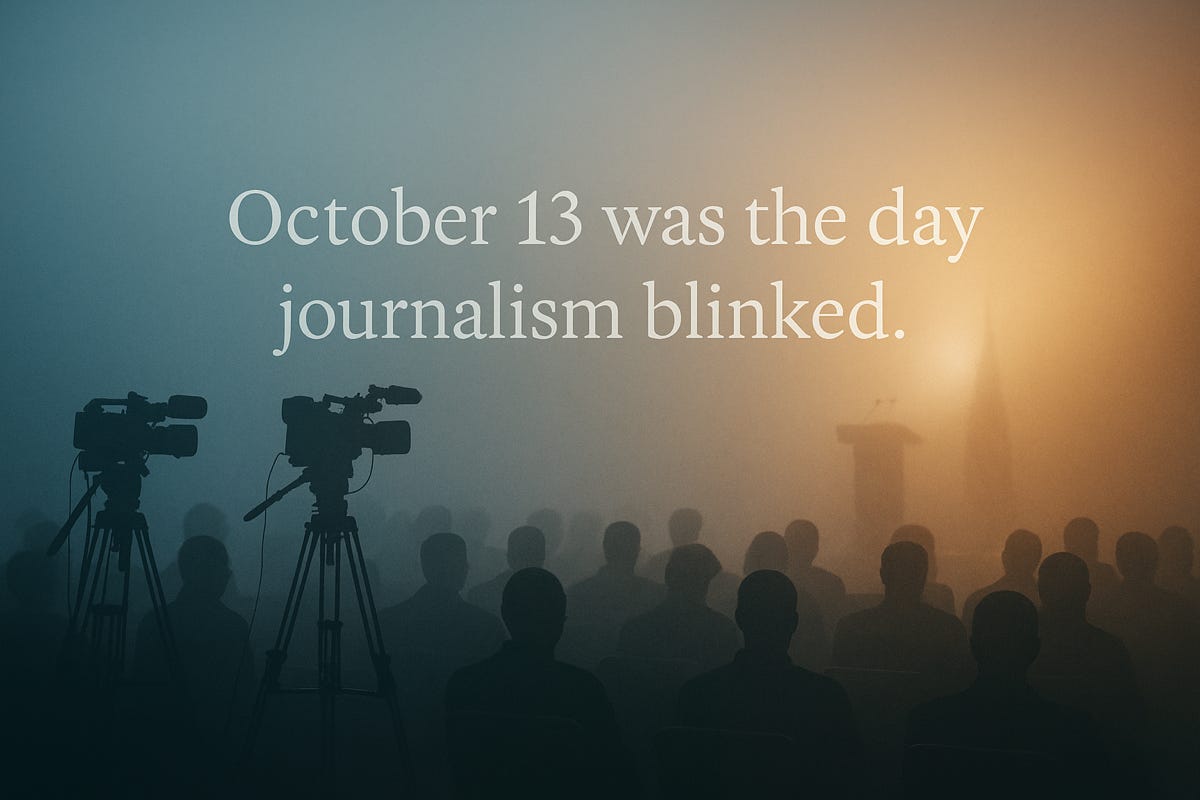The Gaza Deal, Day Two: How the Media Handled History
The Gaza Deal, Day Two: How the Media Handled History
By Jim Reynolds | October 13 2025
Introduction
The first full news cycle after Trump’s Gaza peace accord revealed more than it reported.
Hostages were home, the guns were silent, Arab and Israeli leaders were smiling—yet the press reacted along familiar seams. The same event became, depending on the outlet, either a diplomatic miracle, a cautionary “if it holds,” or a background detail to be buried under campaign chatter.
CNN — Measured, Even Skeptical
CNN filed four substantial pieces: live coverage of Trump’s Knesset speech, a “moment-by-moment” recap, and two analyses on what comes next.
Tone: procedural, slightly wary, but noticeably fairer than usual.
They credited Trump for persistence and diplomacy, stressing fragility instead of mocking motives. Words like historic and significant appeared without sarcasm—a small journalistic breakthrough.
Fox News — The Triumph Narrative
Four Fox stories cast the deal as the culmination of Trump’s world-view:
“achieved the impossible,” “3,000 years in the making,” “golden age of the Middle East.”
It was moral vindication wrapped in patriotism—exuberant, emotional, and detail-rich.
Bias: openly celebratory, but factually aligned with events.
The Guardian — The Eye-Roll
The Guardian published a single item, and it barely discussed peace.
The headline folded Trump’s ceasefire into a list of unrelated controversies, mentioning the deal as an aside.
Tone: ironic, distant, half-smirk. The world’s biggest diplomatic story was treated as scenery in the Trump show.
Daily Caller — Populist and Personal
Four pieces filtered the news through the audience: tearful callers on C-SPAN, believers linking the moment to faith, hecklers removed mid-speech.
This was the emotional right-populist lens—redemption more than geopolitics.
Earnest, partisan, but unmistakably human.
Reuters — Detached and Analytical
Reuters zeroed in on Miriam Adelson’s behind-the-scenes role, viewing the peace deal through donors, influence, and strategy.
Tone: cool and factual, a financial-power frame rather than moral judgment.
Balanced skepticism—neither hostile nor heroic.
Associated Press — The Old Standard
Five AP dispatches tracked every stage: hostages freed, leaders praising restraint, regional voices like Egypt and Lebanon reacting.
No editorializing, no adjectives beyond historic and complex.
The AP served as the chronological backbone for every other network that day.
CBS News — Straight Wire
A single item: “Trump, world leaders sign Gaza peace deal after Hamas frees all living hostages.”
No color, no comment—just a factual feed. Neutral by omission.
Absent Voices
ABC, NBC, and MSNBC did not appear in this dataset.
Their silence remains a kind of stance: when a Trump success story arrives, the safest headline is none at all.
Comparative Takeaway
Fairness improved.
Even CNN and Reuters reported the facts without venom; the AP anchored the center.
Bias survived in tone, not in truth.
Fox and the Caller celebrated; the Guardian minimized; the rest reported.
For once, nearly everyone got the basic story right.
Bias Snapshot (Narrative Summary)
Fair/Neutral: AP, Reuters, CBS
Cautiously Fair: CNN
Positive/Supportive: Fox News, Daily Caller
Dismissive/Ironic: The Guardian
Absent: ABC, NBC, MSNBC
Conclusion
October 13 was the day journalism blinked. Most outlets couldn’t ignore peace, but a few still couldn’t let go of the habit of suspicion.
Even so, the reporting itself was fairer than the reflexes behind it—a rare, historic day when facts briefly outran feelings.
When the bombs stop and the microphones start, you find out who can handle silence. On this day, at least, the truth spoke louder than the spin.



